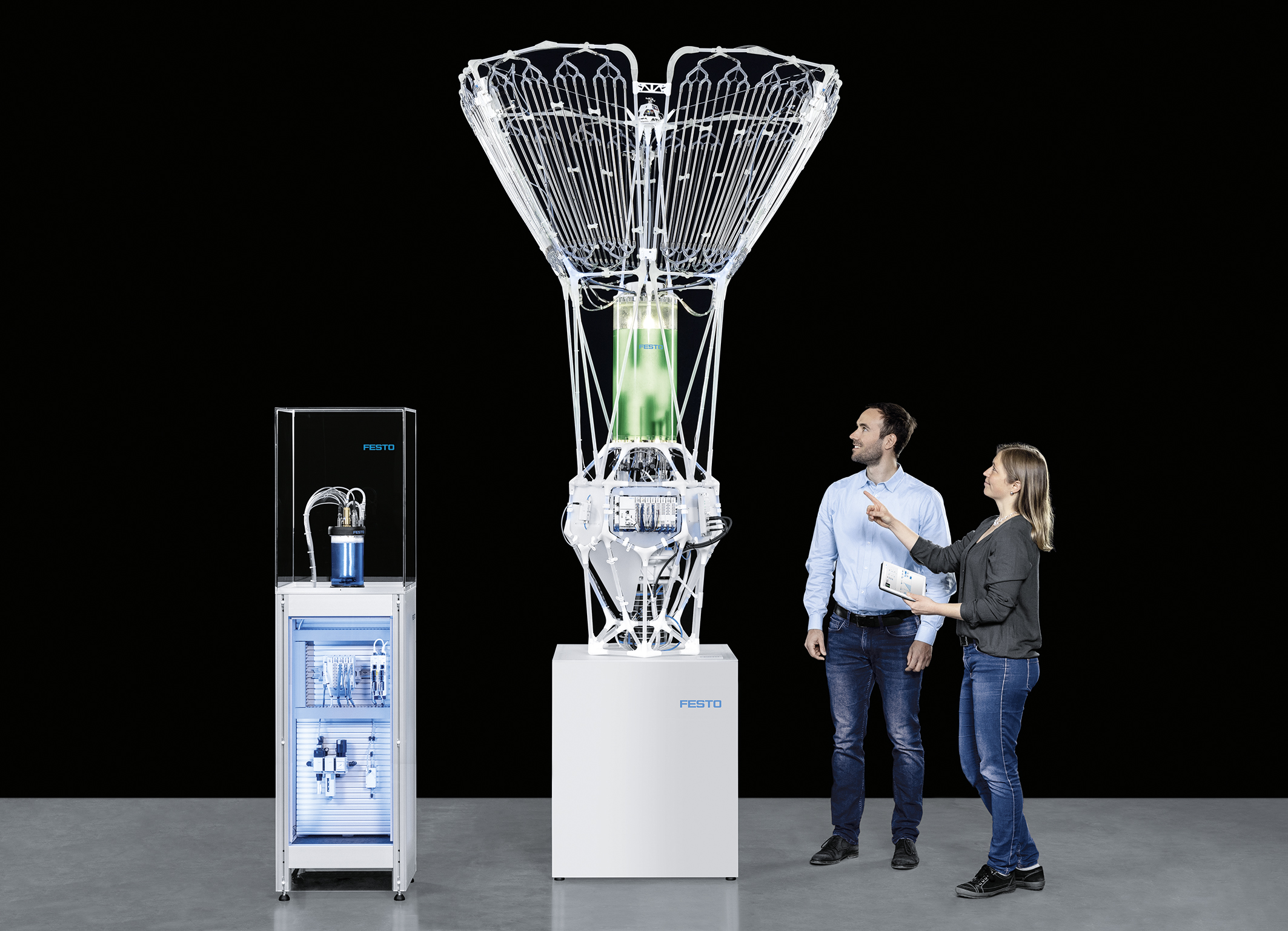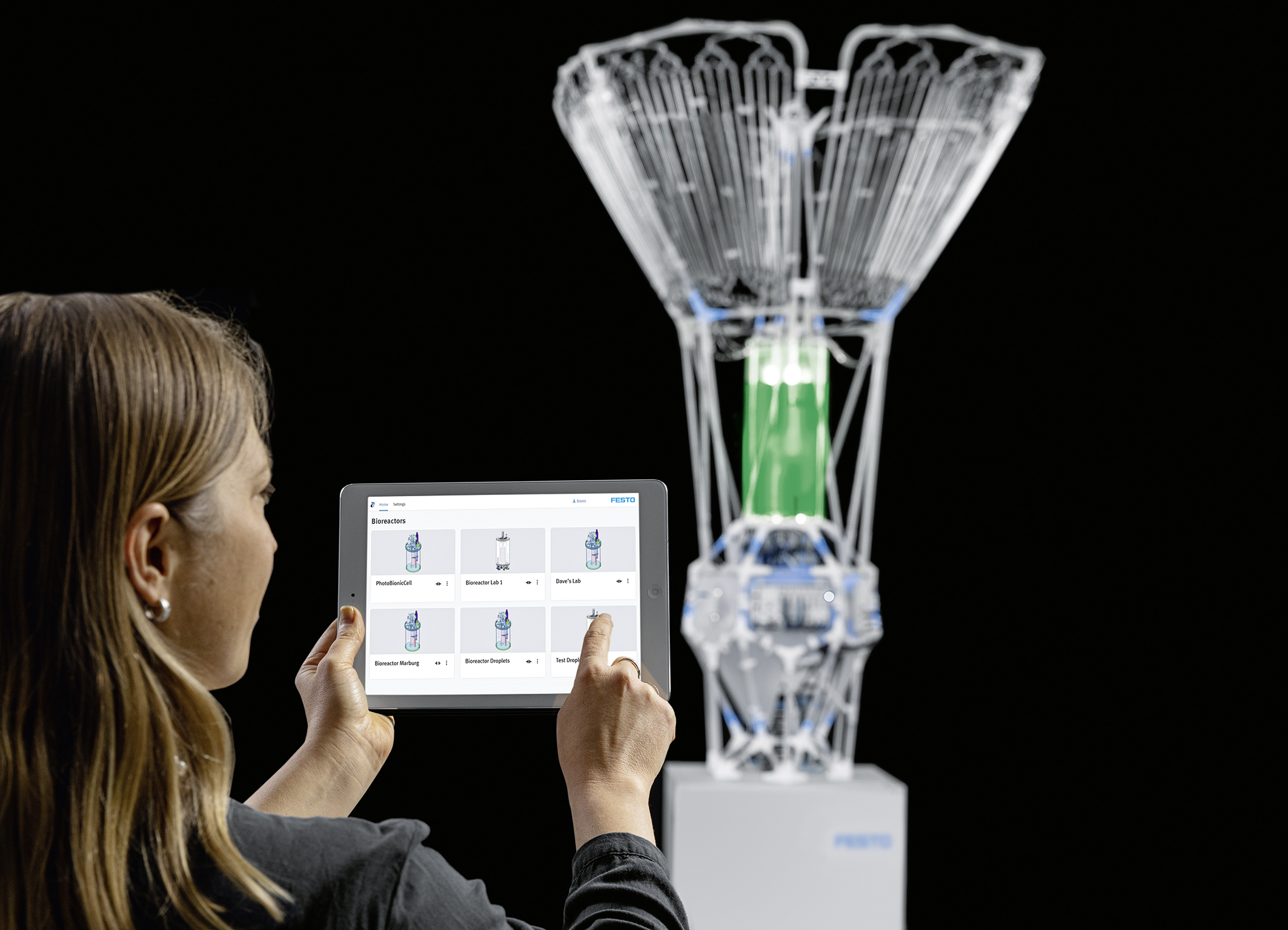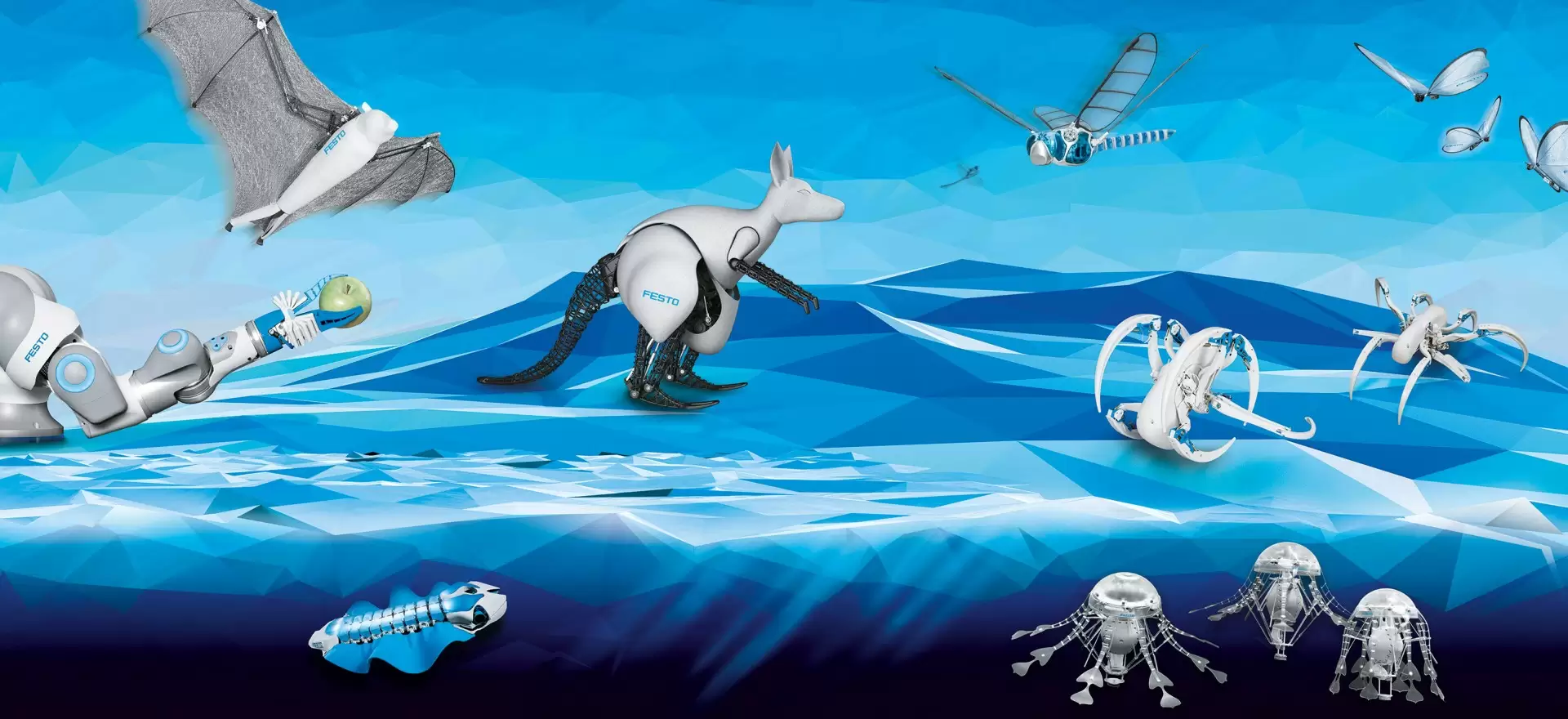Main navigation
Valuable materials of all kinds - produced automatically in living cells
In future, algae could be used to produce practically everything that still requires petroleum, including plastics, fuels, medicines and food. Algae are also climate savers par excellence, because they bind ten times more CO2 than terrestrial plants. Festo, a company based in Esslingen, Germany, has developed a high-tech bioreactor that can be used to automatically cultivate the small green biofactories - and that do so a hundred times more efficiently than terrestrial plants.
We have long known that nature can serve as a model to find solutions for technical challenges in many areas. And "bionics" is no longer just an empty portmanteau word derived from biology and technology that involves interesting thought experiments; it is now being put to practical use. Whether it's truss constructions, self-cleaning surfaces with a lotus effect or the aerodynamics of aircrafts and vehicles - there are already a number of concrete examples that are suitable for everyday use.
The Festo Group in Esslingen - an international specialist in control and automation technology - recognised the importance of natural models years ago. In 2006, Festo founded the Bionic Learning Network, an international research association of universities, institutes and developers, which set itself the task of looking for natural phenomena that can be transferred to everyday in the manufacturing sector. Artificial kangaroos, ants, spiders, elephant trunks, fish fins and chameleon tongues are some of the objects that have already been created.
Small green mini-factories supply raw materials for everyday products

One of the researchers' latest projects involves using living cells as mini-factories for producing a wide variety of valuable materials. The cells can be used for the automated cultivation of biomass in a bioreactor called PhotoBionicCell, which contributes to the increasing biologisation of industry, whose ultimate goal is to achieve a climate-neutral circular economy and reduce the ecological footprint.
"In the Bionic Learning Network, we have been looking into the circular economy of the future for a long time and thinking about how we could contribute to it," says Dr. Nina Gaißert, a biotechnologist in the bionics team. "We also wanted to work with living matter; so when we came across algae, which are perfectly suited to producing different substances depending on the species, we started to develop a bioreactor to combine living and technical components and produce new materials - such as foodstuffs, fuels or plastics - biologically."
Automation creates the perfect living environment - 24/7
Microscopically small algae - microalgae - live in the novel bioreactor in Esslingen. They are so frugal that all they need for healthy growth is a medium consisting of minerals and salts, water, light and CO2. If these components are then made available to them in exactly the right proportions using control and automation technology, the green mini-factories not only produce a huge amount of biomass as a starting material for other valuable substances in our everyday lives, such as fatty acids, colour pigments or surfactants, but they also fix a hundred times more CO2 than terrestrial plants – whilst requiring considerably less land and water than their land-dwelling relatives. In addition, most of the biobased end products can be biodegraded.
The manual component, which is still required for most laboratory work today, is no longer needed; this minimises sources of error and saves time and money: the technical solution developed at Festo for this purpose consists of a fully automated 24-hour algae growth monitoring system, which is as perfect as the microorganisms could ever have in any body of water in the world. For this purpose, the experts developed extensive sensor technology to be able to record, for example, the optimal pH value, the nutrient ratio or the number of algae and the growth rate in the bioreactor. "It is impossible to determine with the naked eye which life cycle the algae are in and whether they are doing well," explains Gaißert. "But the sensor technology allows us to do just that, and that's why the algae can grow as efficiently as possible in the PhotoBionicCell."
A permanent supply of CO2 is essential for the algae to optimally photosynthesise. This is provided by a specially developed aeration element that draws in the ambient air containing huge amounts of CO2 by pumping the algae liquid upwards into the collector arrays and subsequently atomising the air into bubbles to create the largest possible reaction surfaces.
Bioplastic mounting brackets already installed in the bioreactor
What at first glance looks complicated is actually quite simple: for the bioreactor, which laypeople could easily mistake for something akin to a small spaceship combined with a hot-air balloon, an intuitive interface was created that allows users to access all process data and sensor values in real time on a website and thus, for example, find out the optimal harvest time. Artificial intelligence methods are also employed here to produce the best possible environment for algae growth. "Theoretically, you could also access the data from your home office and, if necessary, initiate the harvest immediately," says the scientist. Another tool, an augmented reality app, enables all sensor values to be viewed in real time. This requires only a single fixation with the smartphone - almost as if the user were taking a photo of the reactor.

An algae species called Synechocystis is currently being cultivated in Festo's bioreactor. "We chose this microalgae species after carrying out algae database searches to find a species that is able to produce plastic – in particular the biopolymer polyhydroxybutyric acid PHB," says Gaißert. "But this can be done just as effectively with other algae, such as spirulina. It simply depends on the desired application. In principle, everything that is currently produced from petroleum can be synthesised. However, it is not yet economical enough. What would work well, however, are high-value algal products such as pharmaceuticals."
Plastic production has already worked very well in Esslingen: the researchers were able to extract PHB from Synechocystis cultures and, by adding other substances, be processed into a filament for 3D printing and for packaging material and used, for example, to produce a mounting bracket for the reactor. However, Festo is not considering producing this type of plastic itself: "Our speciality is the reactor drive, supplying the control and regulation technology for the reactor," says Gaißert. "Of course, we would like to scale up the reactor from the current 15 l to a much larger scale, but Festo has no plans to build these devices. For that we would need industrial partners."
Metabolic pathways to be optimised with synthetic biology
In any case, the response to the novel bioreactor has been fantastic: "The Bionic Learning Network traditionally presents our latest projects at the Hannover Messe every year," says Gaißert. "So this year, we presented the PhotoBionicCell, and people were extremely enthusiastic. This of course encourages us to continue working on it and making it even more efficient."
This will involve technical adjustments as well as the use of synthetic biology: Festo is working with the Max Planck Institute for Terrestrial Microbiology in Marburg on the artificial improvement of photosynthesis. Thousands of computer-designed enzyme variants can then be tested using Festo’s automated dispenser, packed into synthetically produced, CO2-fixing artificial cells, so-called droplets, and subsequently be cultivated in the bioreactor. The system has the potential to be transferred to other industrial bioreactors or cells, so that chemical processes can increasingly be replaced by biological ones in the future.
Editor’s note:
From a scientific point of view, many green photosynthesising microorganisms, such as the algae Synechocystis or spirulina mentioned in the article, are part of the cyanobacteria rather than the algae family. Unlike algae, cyanobacteria are prokaryotes and do not have a cell nucleus. However, as they have the ability to photosynthesise, cyanobacteria used to be taxonomically counted as algae and were also called blue-green algae. In common usage and public understanding, however, this aforementioned distinction is not usually made, which is why such species are also often referred as microalgae.
